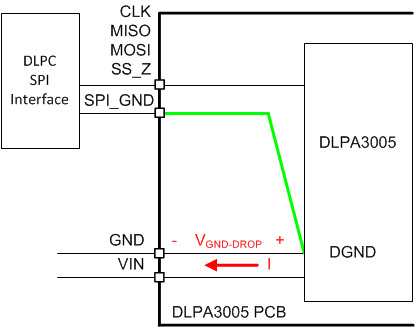ZHCSE88A October 2015 – February 2023 DLPA3005
PRODUCTION DATA
- 1 特性
- 2 应用
- 3 说明
- 4 Revision History
- 5 Pin Configuration and Functions
- 6 Specifications
-
7 Detailed Description
- 7.1 Overview
- 7.2 Functional Block Description
- 7.3
Feature Description
- 7.3.1 Supply and Monitoring
- 7.3.2 Illumination
- 7.3.3 External Power FET Selection
- 7.3.4 DMD Supplies
- 7.3.5 Buck Converters
- 7.3.6 Auxiliary LDOs
- 7.3.7 Measurement System
- 7.4 Device Functional Modes
- 7.5 Programming
- 7.6 Register Maps
- 8 Application and Implementation
- 9 Power Supply Recommendations
- 10Layout
- 11Device and Documentation Support
- 12Mechanical, Packaging, and Orderable Information
10.1.1 SPI Connections
The SPI interface consists of several digital lines and the SPI supply. If routing of the interface lines is not done properly, communication errors can occur. It should be prevented that SPI lines can pickup noise and possible interfering sources should be kept away from the interface.
Pickup of noise can be prevented by ensuring that the SPI ground line is routed together with the digital lines as much as possible to the respective pins. The SPI interface should be connected by a separate own ground connection to the DGND of the DLPA3005 (#DLPS0416575). This prevents ground noise between SPI ground references of DLPA3005 and DLPC due to the high current in the system.
 Figure 10-2 SPI
Connections
Figure 10-2 SPI
ConnectionsInterfering sources should be kept away from the interface lines as much as possible. If any power lines are routed too close to the SPI_CLK it could lead to false clock pulses and, thus, communication errors.